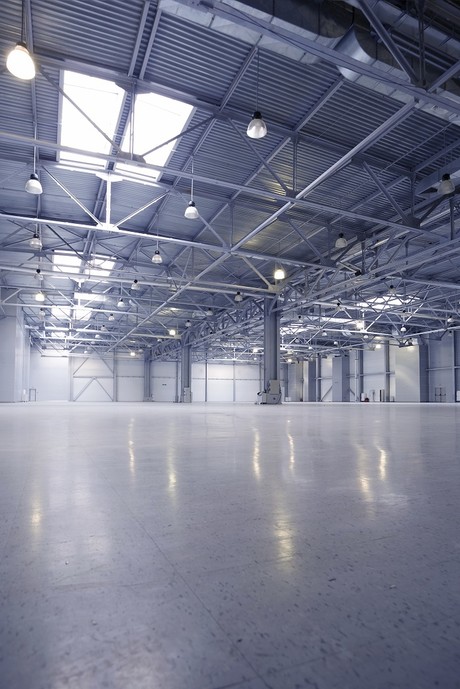Making the switch to LED

When it comes to factory, warehouse and transport depot lighting, traditional lighting systems have typically employed metal-halide light sources. What facility managers and business owners may not know is that these lights are emitting a lot more heat — and burning a lot more energy and money — than is necessary.
Once upon a time, metal-halide (MH) fittings were prized for their brightness, energy efficiency and long life. This is not so much the case now, when compared to light-emitting diodes (LEDs).
MHs work similarly to fluorescents in some respects and incandescents in others. They pass an electrical arc through a gas-filled tube like a fluorescent, but the arc itself creates bright, visible light as is the case in incandescent fittings. This is an inefficient process — about 75% of the energy MHs consume is wasted as heat.
LEDs vs metal halides
Efficiency and energy savings
Since LEDs are inherently directional, they emit almost all of their light output in the desired direction, rather than dispersing it in all directions like MHs. Modern LED high bays can produce 160+ lm/W, compared with around 90 lm/W in the case of a 400 W MH.
Programs such as the NSW Energy Savings Scheme approve products for the creation of energy saving certificates (ESCs) including a number of LED high-bay lights from MatrixLED, which offer significant savings in factory, warehouse and transport depot applications.
As an example, including the ballast with a 400 W MH fixture, the energy saved per light by switching to a 95 W LED high-bay light is around 345 W. If 100 lights operated 24 hours a day, seven days a week for a year, the total annual energy saving equates to 302,215 kWh. At an average electricity price of $0.17/kWh, this is a cost saving of $51,377 per year.
A savings calculator can help businesses work out their potential savings given the number of lights, operating hours and the weighted average electricity price they pay.
Life span
While MHs can generate about 35,000 lumens when initially installed (around 90 lm/W), lumen depreciation occurs quickly. An MH’s light output typically decreases by half within a couple of years.
By contrast, a high-quality LED will last 50,000 hours or longer. An LED does not burn out like a standard lamp, so individual diodes do not need to be replaced on an array. Instead, the diodes gradually produce lower output levels over a very long period of time. If one LED fails, it does not produce a complete fixture outage.
Although LEDs never really burn out, product life span is measured by lumen depreciation. The life of an LED is generally calculated as the point at which the LED reaches 30% lumen depreciation.
It’s important to remember that a 50,000-hour rating for an LED is not equivalent to a 50,000-hour lamp life rating (if such a thing existed). A high-quality LED will function for well over 100,000 hours in its capacity as a light-emitting diode. A high-end LED rated at 100,000+ hours would be used as a light source for approximately 50,000 hours. After that time, it would still be operational, but at a decreased lumen output, and would probably warrant replacement.
Additional comparisons
Relatively high energy use and shorter life aren’t the only drawbacks of MHs; here are a few others:
- MHs require up to 15 minutes to reach full brightness when first turned on and up to 20 minutes before they can be turned on again when they are turned off;
- MHs emit significant heat, which not only reduces their efficiency but makes air conditioning work harder;
- Older MHs can explode with no warning, requiring the use of protective, enclosed fixtures; and
- MHs contain mercury gas and the mercury from discarded bulbs can be harmful to the environment.
By comparison, LED high- bay lights have:
- instant start-up — no warm-up phase;
- reduced running temperatures and heat load on air conditioning;
- no hazardous mercury and environmental disposal issues;
- enhanced compatibility features (they can be easily integrated with advanced dimming and control options);
- exceptional colour rendering;
- zero flicker and fatigue;
- zero ultraviolet light emission; and
- constant output, which does not degrade at low temperatures.
#SwitchToLED
There is no better time, with various government energy savings schemes and incentives, to switch to high-bay LED lighting. For example, in NSW, a business may be entitled to receive ESCs, the number of ESCs being directly related to the amount of energy saved by that business. The ESCs associated with the savings already outlined will reduce the net outlay and achieve payback periods measured in single-digit months.
Woolworths cuts costs and carbon with energy-tracking tech
Australian energy-tracing company Enosi is helping Woolworths to optimise its renewable energy...
Powering research with community batteries
A NSW university will soon receive 10 community batteries, thanks to a project run by Hydro...
Tackling EV misinformation at Everything Electric
Lauren Davis discusses all things EV with Robert Llewellyn, Red Dwarf cast member...




